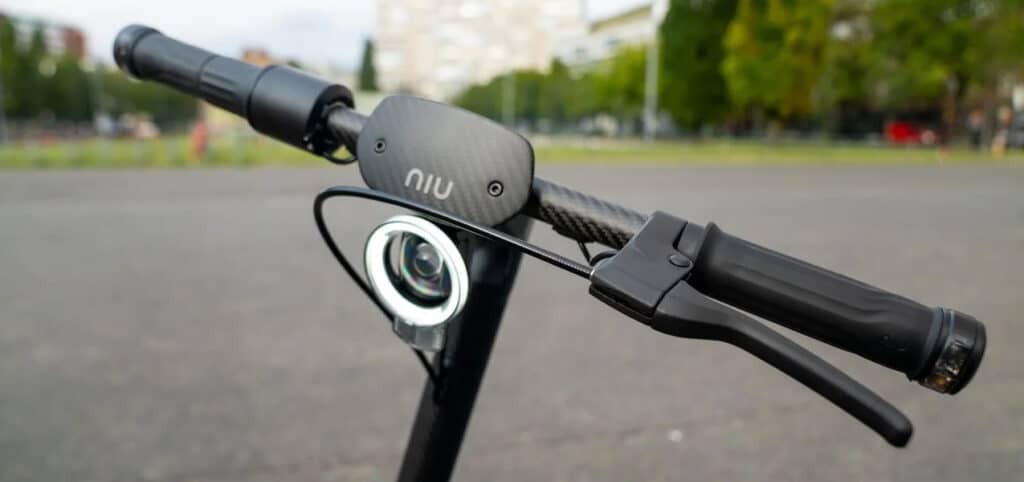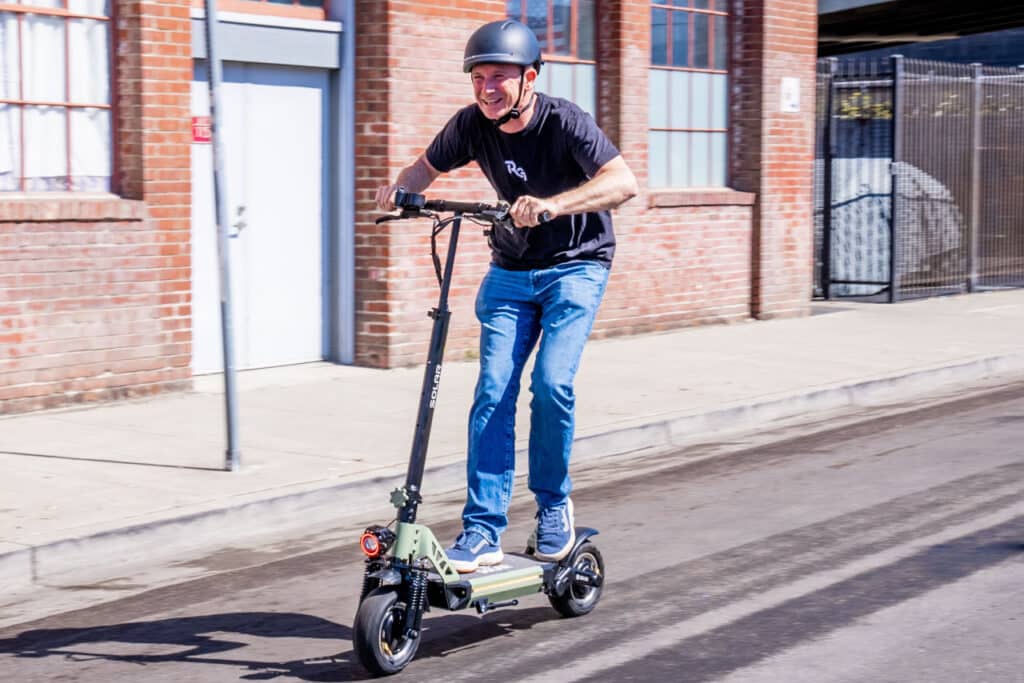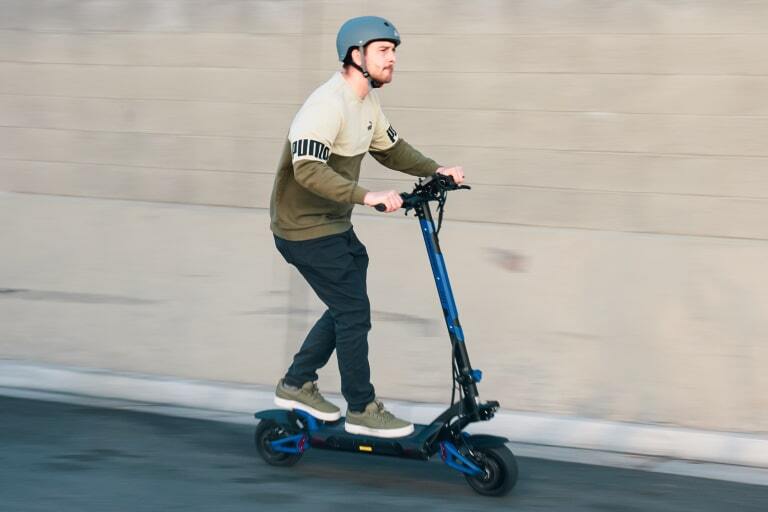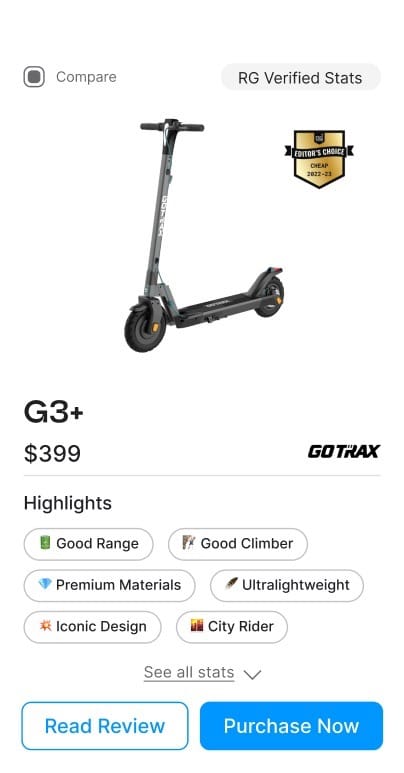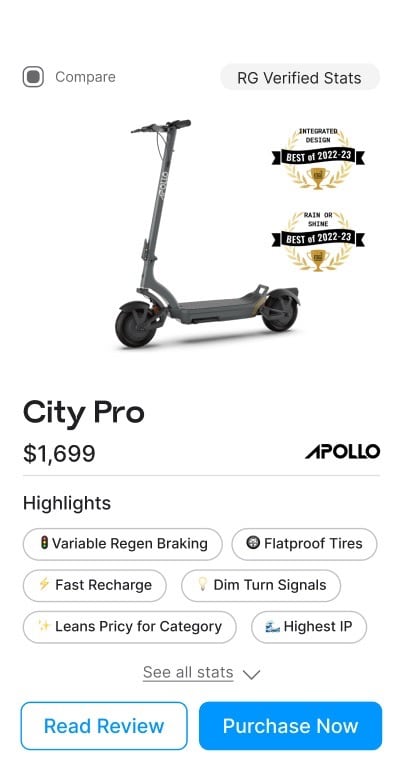
Paul Somerville
Rider Guide’s Editor-in-Chief is a seasoned expert in the electric scooter industry. With a wide-ranging background that includes managing scooter warehouses, selling thousands of motorcycles, and restoring high value (+1M) European sports cars, his expertise is unmatched. Having personally tested more than 100 electric scooters, he offers invaluable insights and recommendations to our readers. We are fortunate to have him as part of our team, as his diverse skill set and extensive experience ensure top-notch reviews.
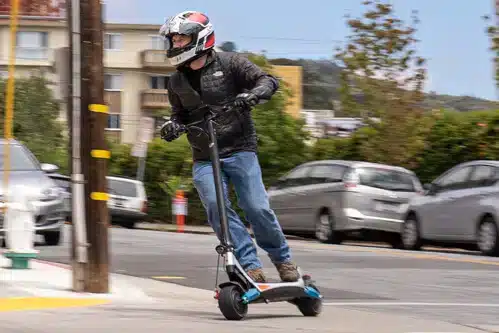

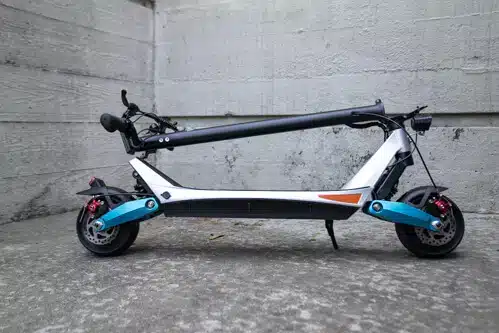
Varla Pegasus Summary

Technical Specifications
Varla Pegasus Alternatives & Competitors


Our Take: Cheap Dual Motor Performs But Needs Love
The Varla Pegasus is priced to be a thrilling, yet inexpensive dual-motor scooter. A fresh look that includes teal swingarms, silver accents, and wide tires tires, help it stand out in a sea of coal-black scooters.

Best of all, it has stellar display that is large and easy-to-read (it’s one of the easiest to read — ever — thanks to its size and giant digits).
Varla has also clearly taken note of rider feedback and opted for a more comfortable, easier-to-control thumb throttle.

Our Pegasus arrived needing a tune-up straight out of the box, which is unwelcome but not completely unusual. Build quality is acceptable, but not amazing. However it’s hard to be too critical at this bargain price-point.
Our biggest beef with the scooter is ride quality.
Varla opted for small, airless, super-wide tires that have a flat profile. These, of course, are immune to flats which is a selling point for maintenance.

However, the rubber compound is really stiff and makes a resounding thud that tends to bounce you around — rather than smooth out rough terrain. The flat tire profile makes for some awkward cornering and takes away nimbleness you’d otherwise expect in an 66 lb scooter.
Ultimately, the Pegasus feels like a competitor aimed directly at the Mercane WideWheel Pro or Zero 8X. It’s fast, fun, cheap, but ride quality make it more suitable for recreating than serious long-haul daily commuting.
Varla Pegasus Review
Performance Summary
| Acceleration (0 to 15 mph) | 2.6 seconds |
| Acceleration (0 to 20 mph) | 4.3 seconds |
| Acceleration (0 to 25 mph) | 9.5 seconds |
| Top speed | 25.0 mph |
| Braking distance (15 to 0 mph) | 9.2 feet |
| Range | 18.2 miles |
| Hill climb | 9.5 seconds |
Acceleration

We test all electric scooters in their highest performance settings, engaging dual motors and setting acceleration to its highest level.
The Pegasus feels peppy off the line, with a 0 to 15 mph time of 2.6 s. It will beat out most single motor scooters. However, it loses some of its lead as it approaches top speed, hitting 25 mph after 9.5 s.
Top Speed

With a 25.0 mph, the Pegasus is not as fast as some scooters. However, this speed is really as fast as you want to go on this scooter.
At speeds over 20 mph, steering gets wiggly and doesn’t give the rider a stable, confident feel, which is why the Pegasus is better described as a quick cruiser than a road-ripping warrior.
Hill Climb
The Pegasus is a surprisingly strong hill climber, getting up our 200 ft, 10% average grade test hill in 9.5 s at an average speed of 14.3 mph.
Range
We perform all range tests on the same loop, which includes turns, stops, starts, and some uphill riding with a 165 lb rider. We ride the scooter as fast as is safely possible until the battery management system cuts the power, and then make the dreaded walk of shame back to RG Labs.
Have range anxiety? Check out our list of the longest range scooters.
The Pegasus goes a good distance, getting a tested range of 18.2 mi. However, the end of the range test came very abruptly, and the scooter stopped running before the last battery bar was depleted.
When the Pegasus stopped during testing, we thought a motor malfunction had occurred because it halted so hard. Also, it made bad motor noises when the end came. After charging all seemed well again, but it was a bit disconcerting when it happened.
Braking

The Pegasus comes with dual disc brakes, and they needed adjustment for the scooter to be rideable. The inner pad on the rear tire wasn’t making contact with the rotor, and the actual caliper was hitting.
Braking was surprisingly strong once tuned, but was very bad out of the box.
In our braking test, our rider brings the scooter to an emergency halt from 15 mph. The Pegasus had an excellent braking distance of 9.2 ft. Being able to come to a stop in such a short distance is exceptional and helpful for preventing accidents and avoiding obstacles.
Ride Quality
Unfortunately, the first thing that you notice when you jump on the Pegasus is the tires. We kinda hate them.
They are solid 8.0 in tires that don’t provide the smoothest ride, but are a few things to like about them.
First of all, they have a bit more grip than expected, are are immune to flats — a huge plus in the maintenance department.
However, their small diameter makes the scooter less stable at higher speeds, and you can’t give it much handlebar input without feeling like you’re going to topple over.
If you try to lean into corners, you’ll start to feel the sharp profile of the wheels, and the contact patch of the tires losing traction with the pavement.

The dual spring suspension does an admirable job of making the tires work as well as they possibly can. The dual springs and long wheelbase, provides one of the better suspension systems we’ve experienced, but the tires reduce its overall effectiveness.
If the Pegasus had air-filled tires, even small ones, it could have been an amazing ride, but as-is it waivers back and forth between receiving a C and a B+ letter grade, depending on terrain.
Varla Pegasus Features
Portability
In general, the Pegasus is not very portable. It has folded dimensions of 25 in wide by 48 in long by 20 in tall, and weighs 66 lb, which is a pretty large scooter for some riders to handle.

The handlebars don’t fold, the deck is fairly long, and the stem is a bit difficult to unlatch (with one of our least favorite folding mechanisms). It isn’t robustly made, as the adjuster inside of the mechanism has no locking bolt, and could potentially come loose while riding.
Although the stem latches to the deck for easier carrying when folded, there isn’t really a good place to pick up the Pegasus from the rear if you wanted to lift it without folding.
Cockpit

This is a big claim, but the Pegasus just might have the best display ever (even better than the display on the Apollo Phantom, the brand new Nami Burn-E, and the tech-forward Inokim Quick 4 Super).
Many high performance scooters have QS-S4 or EY3 throttle displays, but more scooter manufacturers are upgrading to larger, more robust dashboards. The 3 in by 2 in rectangular LCD display on the Pegasus is by far the easiest to read in full sunlight and complete darkness, and this was probably the most shocking thing that we love about it.
Although we aren’t in love with the style of the text, it’s very easy to read with large fonts and icons that you can recognize from a distance, including a battery readout that spans the entire top of the screen. It’s very, very, very good.
The handlebars are weirdly tilted away from the rider and can’t be adjusted into a closer orientation, because there is no excess cable length to allow it. Also, the bars have “L” and “R” engraved on them, so you’ll always know left from right (and get to look at that forever).

However, they’re capped with flat-palm handgrips that are pretty nice, and the plug-and-play cabling is wrapped and routed neatly into the stem. There are brake levers on both handlebars, with a simple bell on the left.
Also on the left is the 3-button console, which is rubber coated and feels good. Use these buttons to turn on the scooter, toggle through and select settings, and turn on the lights.

On the right handlebar is the thumb throttle, which is one of our favorite designs, and the large display is centered over the stem. The throttle has a bit of an abrupt start when you first engage it, and we would like acceleration to be more progressive, but that’s true of almost every scooter we’ve ridden.
Note: The tapered thumb throttle on our Pegasus appears to be a different style than the rectangular thumb throttle featured in other photos that we’ve seen online, and we’re not sure which will end up in final production models.
As with most performance-level scooters, you can control factors like acceleration, regenerative braking, and riding mode using p-settings. Here’s a guide to p-settings for the Pegasus.
P-settings for the Varla Pegasus
| Setting | Feature | Notes |
|---|---|---|
| P1 | Backlight brightness |
1: low
|
| P2 | Speedometer units |
0: kph
|
| P3 | Battery voltage (do not adjust) |
Default: 48V
|
| P4 | Auto-off time |
0: not set |
|
P5 |
Gear number (do not adjust) |
Default: 0 |
|
P6 |
Rim size (do not adjust) |
From 0-50 |
|
P7 |
Motor magnets (do not adjust) |
Higher value means lower speed |
|
P8 |
Power level |
1: slowest |
| P9 | Start mode |
0: zero start |
|
P10 |
Running mode (do not adjust) |
0: only PAS, no throttle
|
| P11 | PAS start sensitivity (do not adjust) |
From 1 to 24 |
| P12 |
PAS start strength (do not adjust) |
From 1 to 5
|
|
P13 |
PAS sensor type (do not adjust) |
Value: 5/8/12
|
|
P14 |
Controller limit (do not adjust) |
From 10-20
|
| P15 | Controller voltage protection (do not adjust) |
Default: 40
|
|
P16 |
Lifetime odometer reset |
Long-press Up button for 6 s to reset to 0 |
| P17 | Cruise control |
0: off |
|
P18 |
Speed indication ratio (do not adjust) |
From 50-100% |
|
P19 |
0 gear setting (do not adjust) |
0: no 0 gear |
| P20 |
Communication protocol (do not adjust) |
0: no 2 protocol |
Error codes for Varla Pegasus
If you have issues with your scooter, the scooter’s dashboard will often display an error code. Here are the error codes and the associated faults for the Pegasus.
- E006 Battery under voltage
- E007 Motor faulty
- E008 Throttle faulty
- E009 Controller faulty
- E010 Communication receive faulty
- E011 Communication sending faulty
- E013 Headlight faulty
Lights
The headlight is somewhat bright, but it’s low mounted doesn’t help light up much of the road ahead. Other vehicle will be able to see you, but you may not see them.

It rattles annoyingly when riding, and isn’t mounted high enough to help illuminate the road ahead. To turn on the headlights on the Pegasus, you have to power on the scooter, then long-press the “up” button. Another nice feature of the display is that it indicates when the lights are on.

The red fender-mounted taillight is good quality and flashes in three stages of brightness when the brakes are applied. There are also orange reflectors on either side of the front of the deck.
We recommend brighter, higher mounted, and more lights for night riding.
Tires
First off, we just don’t care for these solid road tires, which are 8.0 in diameter by 3 in wide on split rims.

They are almost exactly the same size and profile as those on the Zero 8X, with a slightly different tread pattern.
They provide great traction when stopping in a straight line, but feel very bad when you’re leaned over hard. They also have that solid tire thud when you hit things.
They’re zero maintenance, and the split rim makes it much easier to replace when the tread wears down, but a different choice of tire would absolutely transform this scooter — in a good way.
Deck
The deck of the Pegasus is beautiful.
The silicone-covered surface has a nice grippy pattern and shape to it, extending up the rear fin and edge to edge across the 6.7 in wide by 19.7 in long deck, which rides 3.3 in off the ground.
The angled fin is good for pushing yourself forward under hard throttle, but would give more stability for the rear foot if it were wider, which is much needed at speed. For testing, our stance was rear foot on fin during acceleration, and rear foot square on the deck for normal riding.
Build Quality
The Pegasus has a different appeal than many other dual motor scooters, as it looks (and rides) more like a cruiser than a high-performance rocket.
It has a unique color palette with teal swingarms, a silver deck, gray and black handgrips, and some red details (like the brake calipers). The mixed colors come off a bit mishmash, looking more quirky than sporty.
The Pegasus has IP54 water-resistance, a welcome addition for all-weather commuting. If you do end up riding in the rain, take care with stopping and starting quickly — especially considering solid tires can get pretty slippery when wet.
And here’s why the Varla Pegasus requires a rider that’s willing to wrench.
Our Pegasus Needed a Tune-up Straight Out of the box
When we got the scooter out of the box, we discovered that the rear brake set up was terrible.
The brake caliper was making contact with the rotor instead of the brake pad. The design is such that the brakes really need a shim between the caliper and the bracket to perform properly.
We also had to fix the rotors, which were bent, for the brakes to work. Check out our how-to guide for how to straighten warped rotors.
For performance testing, we kept the configuration as-is to best represent how it would be for any rider receiving the Pegasus, and adjusted the brakes to the best position we could. The Pegasus probably paid a range penalty from the amount of drag caused by the brakes, but that’s what it took to make the brakes work.
Pegasus Folding Mechanism may not Have the Best Longevity

Another downside to the design is the folding mechanism.
The front latch was so tight out of the box that we could barely open it using both hands. We were able to loosen this a bit, but recognized that there’s no adjuster screw (as with other similar designs), allowing the rider to tighten the internal post for a secure stem.
Observing how the stem engages and expecting how it will wear over time, it doesn’t appear to have longlasting durability.
Pegasus Cables are a Little Complex
When assembling, it will take the owner a bit of know-how as the cabling is a little complicated, and could result in some customers pinching and destroying cables right out of the box.
However, there is a pretty detailed guide in the owner’s manual, so assemble carefully and with guidance.
Pegasus Includes Some Nice Accessories
The Pegasus arrived in good condition and solid packaging, and came with some nice additions in the box.
Along with an owner’s manual, the Pegasus comes with a chain lock with two keys, an Allen wrench multitool, a spare kickstand and spare anchor ring (for latching the stem to the deck).
The chain on the lock is nylon wrapped and good for quickly securing your scooter on the go. It’s also lightweight and small enough to throw in your backpack, making it a great accessory for Varla to include.
However, we always recommend a U-lock for the best scooter security.
Varla Pegasus: Review Conclusions

The Pegasus really is a great value, for the right rider, at $1,099 — with some caveats.
It sets itself apart from the crowd with its looks and surprising stats for the price, but pales in comparison when it comes to build and ride quality. It’s a well-performing scooter for someone that can tune it along the way.
With low-maintenance tires, a nice deck and sweet display it’s got some great qualities for city life, but isn’t lightweight or compact for last-mile transfers to other types of transit. For daily riding, it isn’t the most robustly built but still makes a good choice for riders looking to go fast (on good terrain) on a budget.
Varla Pegasus Manufacterer's Specifications
| Make | Varla |
| Model | Pegasus |
| Weight | 66 lb |
| Folded dimensions | 48 by 25 by 20 in |
| Motor power, continuous | 1000 W |
| Top speed | 28 mph |
| Range | 28 mi |
| Battery capacity | 749 Wh |
| Battery recharge time | 7 to 8 hrs |
| Max rider weight | 280 lb |
| Brake type | Disc + Disc |
| Tire type | 8.0 in Solid + Solid |
| Built-in lights | Front + Rear |
| Water resistance | IP54 |





Related Reviews





